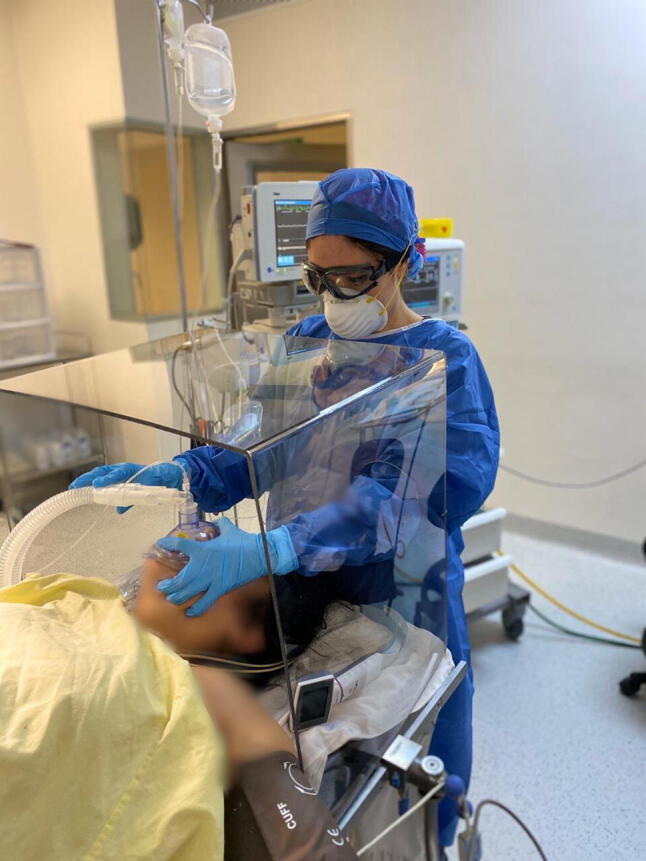Intubating and extubating patients in the operating room represents a high risk of exposure to aerosol droplets. Personal protective equipment must be utilized to protect surgical staff during the current COVID-19 outbreak. As the availability of protective gear diminishes in many healthcare settings, new reusable equipment is urgently needed. This situation prompted us to implement a new improvised barrier, denominated “Aerosol Box” (AB).
Originally based on Dr. Lai’s design [1], we replicate a 50cm × 50cm × 40cm polycarbonate sheet AB (Fig. 1), a suitable material to provide a transparent structure. This device is reusable, easy to produce, and resistant to high temperatures [2], with an approximate cost of $40 USD per box. The AB allows the physician to cover the patient’s head and manually undergo endotracheal intubation (Video1) and extubation (Video2) through two circular box openings, hence reducing the area of contact to expelled aerosol particles during the procedure [3]
Fig. 1.

Colocation of Aerosol Box
Upon our experience with five patients, we encountered minor difficulties limiting the physician’s range of motion during the procedure, although not cumbersome enough to halt laryngoscopy maneuvers or impede endotracheal tube placement. We recommend performing video laryngoscopy-assisted endotracheal intubation by an experienced anesthesiologist, previously utilizing training manikins; however, standard laryngoscopy can be performed if the video laryngoscope is not available. It is imperative to remove the AB if it represents an impediment to the healthcare provider during the procedure sequence.
Maneuvers to support the physician during the procedure can be done by introducing the assistant’s hand through the open side of the AB. These maneuvers include applying cricoid pressure, securing the endotracheal tube and removing the guide wire, while simultaneously attempting to intubate the patient under the covered area by the AB. To reuse the AB, we cleaned the surface areas with 5000 mg/L bleach.
The world is facing an outstanding sanitary crisis and we, as the healthcare system’s frontline force, are fighting to provide the highest quality of care to our patients while protecting our safety. This challenge represents an enormous responsibility, held by a commitment to our community and ourselves.
Our AB model has proven to be a valuable resource in our center, functioning as an adaptive tool to aid in our resource-limiting setting. The AB did not represent an obstacle to our established protocol, and we believe it can be one of the eagerly sought solutions in low- and middle-income healthcare settings facing this pandemic.
Electronic supplementary material
Below is the link to the electronic supplementary material.
Intubation sequence with Aerosol Box (MP4 9656 kb)
Extubation with Aerosol Box (MP4 5404 kb)
Acknowledgments
We thank Dr. Luigi Pellegrini and Dr. Fernanda Covarrubias for providing the videos and image illustrated in this paper.
Compliance with ethical standards
Conflict of interest
The authors certify that they have no involvement in any organization with any financial or non-financial interest, in the subject matter discussed in the manuscript.
Footnotes
Publisher's Note
Springer Nature remains neutral with regard to jurisdictional claims in published maps and institutional affiliations.
References
- 1.Lai HY, Design A (2020) Aerosol box-design. [online] Sites.google.com. Available at: <https://sites.google.com/view/aerosolbox/design> (Accessed 29 March 2020)
- 2.Maddah HA. Polypropylene as a promising plastic: a review, American. J Polymer Science. 2016;6(1):1–11. doi: 10.5923/j.ajps.20160601.01. [DOI] [Google Scholar]
- 3.Canelli R, Connor C, Gonzalez M, Nozari A, Ortega R. Barrier enclosure during endotracheal intubation. N Engl J Med. 2020 doi: 10.1056/NEJMc2007589. [DOI] [PMC free article] [PubMed] [Google Scholar]
Associated Data
This section collects any data citations, data availability statements, or supplementary materials included in this article.
Supplementary Materials
Intubation sequence with Aerosol Box (MP4 9656 kb)
Extubation with Aerosol Box (MP4 5404 kb)


